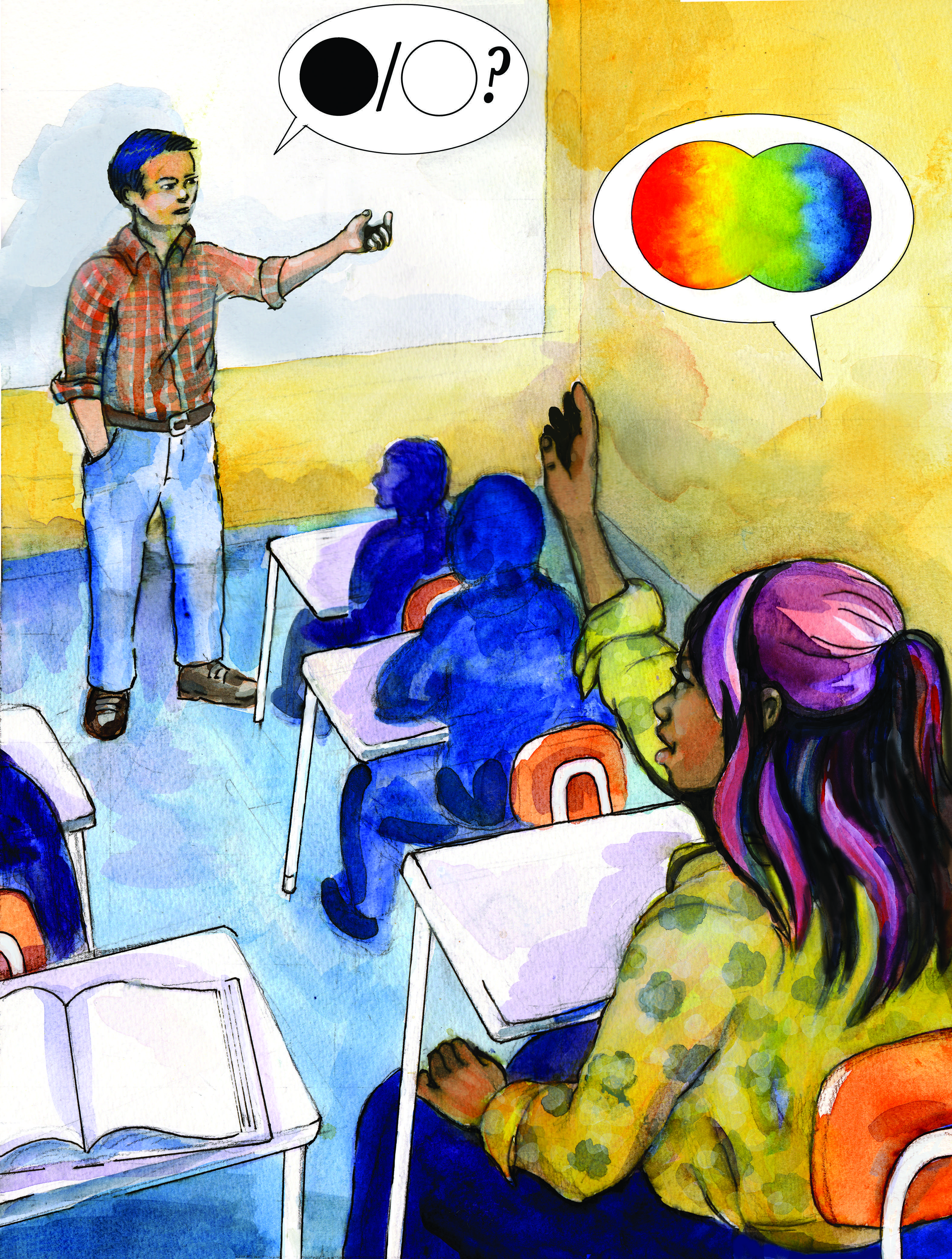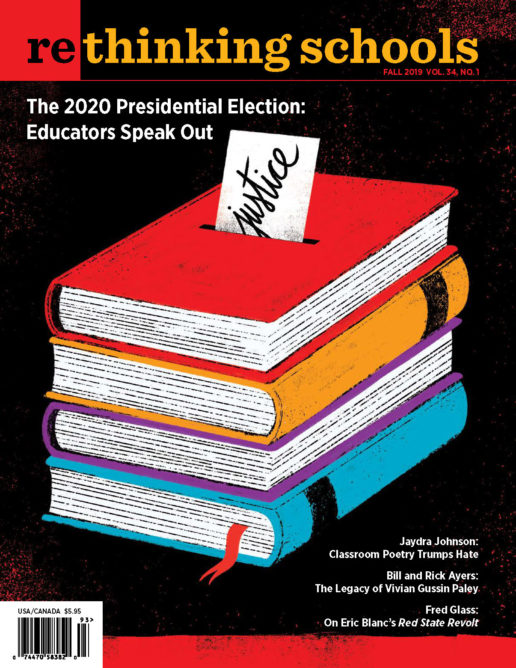Diversity Is What Makes It Interesting to Study Living Things
Teaching gender diversity in biology
Illustrator: Bec Young

I was raised the child of scientists. Science had always been an ally and a comfort, and science was never used against me — not until my junior year of high school.
It was fall 2007 and I had just come out as a transgender boy. In my newly shorn hair and baggy jeans, I sat down with my school’s assistant principal to discuss the logistics of my transition.
Could I use the boys bathroom? “No, you’re not biologically a boy.”
Could I use the girls bathroom? “No, your appearance may scare the other girls.”
Could I use the single-stall bathroom near the main office? “No, that’s only for staff.”
The message was clear: Biological or anatomical traits outweigh personal conviction in deciding whether someone is male or female. People who transgress the gender binary are scary, and they don’t deserve access to the same education as others.
These days, more than a decade later, people who transgress gender norms are still marginalized, and the excuse is often the same, oversimplified appeal to “biology.” Trans people are told to stay out of public restrooms, a restriction that often amounts to avoiding public life altogether, all for the supposed comfort and safety of “biological” women and men. Intersex and trans female athletes are barred from competition amid unfounded concerns that their “male” physiology provides an unfair advantage. A total of 17 states require a trans person to undergo surgery before amending the gender marker on their birth certificate. Three states outright refuse to amend an M to an F or vice versa.
These practices all treat gender, in a scientific sense, as a rigid and immutable binary.
But I am now a high school biology teacher and I know that true, complete biology is incredibly diverse.
The biology classroom has more than enough room to include and celebrate all genders. Like most teachers, I feel the pressure to get through my curriculum and prepare for standardized tests. But when I teach about the complexities of gender, I generate authentic student engagement that drives learning throughout the year.
Language Matters
When we talk about gender in our classrooms, the words that we use can shape the ideas that students take away. It is useful for the class to discuss key terms and agree upon explicit definitions in advance of using the language in an academic context.
As I planned out my genetics unit for the winter quarter, I knew that gendered language would come up in almost every lesson. So I frontloaded some of those conversations. On the first day of the unit, I wrote a statement on the board: “I got half my DNA from my mom and half from my dad.” For most of my 9th graders, this was either a review of middle school science, or it was knowledge so common they couldn’t remember where they’d first heard it. I asked the class, “Is this statement inclusive? Is it true for every person, or are some people excluded?”
“Of course it’s true for everyone,” Jasmine blurted out.
I asked, “Really? It’s true for every single person?”
After some wait time, Manuel raised a cautious hand. “Well, some kids are adopted so they didn’t get any DNA from their parents.”
Now students could see where this was going. I asked for more examples of people who are excluded. I got people with step-parents, same-gender parents, and with a little prompting, transgender parents. I said to the class, “So not everybody has two people in their family called mom and dad, who are the ones that gave them their DNA. And that’s all totally normal and common — the world has all kinds of families.”
Although my students had been speaking in third-person, I knew that a lot them lived with blended families and step-parents. I offered up my own experience. “My dad, who raised me and my sister since we were 3 years old, is a step-dad. We’re not related by blood, but he’s my dad — he’s my real dad.”
I told the class that when we talk about the two people who provide the genetic material to make a new person, we call them the “biological parents.” Each person gets their DNA from their “biological parents.” This word choice has its own connotations, and you may choose to use something different in your classroom. My colleague and friend Lewis Maday-Travis opts to have his students decide collectively on a term, such as “gene giver” or “egg contributor/sperm contributor.”
I took my class through a similar discussion on the statement, “Men produce sperm cells and women produce egg cells.”
“Is it true for everyone, or are some groups excluded?”
Without difficulty, students thought of people who are infertile, people who have reached an age where they stopped making egg or sperm, and transgender people.
I asked the class, “Are transgender women not women just because they don’t make eggs? Are infertile men not men just because they don’t make sperm?” The class came to an agreement that producing reproductive cells is not what makes somebody a man or a woman.
I said, “Then we will have to be precise with our language. We’ll say that ‘people with ovaries,’ or maybe even ‘people with functioning ovaries’ produce egg cells, instead of ‘women’ produce egg cells. That way, all of human experience is included in our language.”
This was not a challenging concept for my students. Later in the same lesson, to check for understanding, I asked Joel, “And where do these chromosomes come from?”
“From the egg and the sperm,” Joel responded without pause. Not “From the mom and the dad.” He had internalized a language for genetics that was both inclusive and rigorous.
From Pathology to Pride
All through our genetics unit, I thought about how our language directs what we think of as normal or abnormal. When a student brought up mutations, which we hadn’t officially covered yet, I described a mutation as a “mistake” in the DNA sequence. But why should we talk about mutations, including the ones causing red hair or blue eyes, as if they’re abnormal or undesirable? When the lesson on mutation came around, I made sure to define it as a “change” in the DNA sequence.
For years, students in my school have done a research project on “genetic diseases.” They choose from a list of diseases caused by single-gene mutations, then report on how the mutation leads to the physiological and social effects of the disease. I push students to read blogs, watch YouTube videos, and look through Reddit forums as ways to understand the personal experiences of affected individuals rather than only learning from medical websites. I remind them often that not all online content is information and that all content has an author with their own perspective that must be interrogated before being considered a reliable source.
This year, in response to high curiosity from students, I expanded the research topic list to include some intersex traits. These occur when genetic mutations lead to the development of reproductive anatomy that doesn’t seem to fit the typical definitions of male and female.
Halfway through the project, the implications of our language occurred to me. Why call intersex a “disease” when many intersex people understand it as a natural variation in human bodies? Indeed, the combined prevalence of all intersex traits is about as common as red hair. For the next year, I changed all the project documents to say “genetic trait” rather than “genetic disease.”
I feel this language better encompasses the diverse ways in which people experience their own DNA. Some mutations, like the BRCA alleles associated with breast cancer, are generally viewed as pathologies to be treated. Others, like the mutations causing some forms of dwarfism and intersex traits, become core components of identity and sources of pride for many individuals.
Diversity Is Never Boring
My students show me that they are coming to think of genetic variation as a ubiquitous fact of life, and a source of endless fascination. They ask me questions about whether certain variations could exist, from variations that they’ve dreamt up, to powers they’ve seen in a superhero movie. My students are more engaged in learning about the complexity of sex determination — the events during cell division that can lead to individuals with XO or XXY sex chromosomes — than they are in the typical XX/XY sex chromosomes.
When a student asked about how twins are made, we sketched out the embryonic development of fraternal versus identical twins. For fraternal twins, the diagram shows two large, circular egg cells each being fertilized by a different long-tailed sperm cell. This creates two siblings who share 50 percent of their DNA on average. For identical twins, the diagram shows just one egg joining with one sperm, creating a zygote that divides into two cells, then four, eight, 16, and so on. When the ball of cells physically splits, we get two siblings who share 100 percent of their DNA.
With this sketch in mind, I asked the class to reason out whether genetically identical twins could be boy-girl twins. The answer ends up being yes, with gender transition making it all possible. Actress Laverne Cox is a trans woman with a cis male identical twin who once played Laverne’s character in a pre-transition flashback on television. I myself am a trans man with an identical twin sister, and when I share this fact, not a single student is bored. They want to know: “When did you know that you were trans and she wasn’t?” “Is there a gene that makes you trans?” “Did you and your sister do the same things as kids? Can we see a photo?”
Diversity is what makes it interesting to study living things. By talking about gender diversity in our classrooms, we can engage minds, de-pathologize difference, cultivate empathy, and support academic rigor for all.
Sam Long (he/him) teaches high school science in Westminster, Colorado and trains teachers across the country on developing gender-inclusive biology curriculum. You can learn more about Sam’s work at sam-long.weebly.com.
Resources for gender-inclusive biology education
Barash, David P. 2012. “The Evolutionary Mystery of Homosexuality.” The Chronicle of Higher Education. Nov. 19. bit.ly/BarashArticle
Kremer, William. 2014. “The evolutionary puzzle of homosexuality.” BBC News. Feb. 18. bit.ly/KremerArticle
Maday-Travis, Lewis. “6 Ways I Make My Science Class LGBTQ-Inclusive as a Trans Teacher.” GLSEN. bit.ly/Maday-TravisArticle
Dzurick, Alex. 2018. “A Culture of Acceptance.” The Science Teacher. April 1. bit.ly/30Rh92l
Freeman, Jon. 2018. “LGBTQ scientists are still left out.” Nature. July 3. https://media.hhmi.org/biointeractive/click/testing-athletes/
Yoder, Jeremy B. and Allison Mattheis. 2015. “Queer in STEM: Workplace Experiences Reported in a National Survey of LGBTQA Individuals in Science, Technology, Engineering, and Mathematics Careers.” Journal of Homosexuality. Aug. 4. http://dx.doi.org/10.1080/00918369.2015.1078632
Project Biodiversify: projectbiodiversify.org — A site with tools for promoting diversity and inclusivity in biology classrooms.
HHMI Sex Verification Interactive: https://media.hhmi.org/biointeractive/click/testing-athletes/introduction.html — A site where students and teachers can learn about the history of sex verification of athletes.
World Health Organization: Gender and Genetics: bit.ly/2oRytqP — Learn about ethical, legal, and social implications of gender and genetics.
Matt Gilbert’s Sex Chromosome Meiosis Game: mattgilbert.net/biologygames/meiosis/index.html — Use this site to explore origins of some intersex traits.
interACT-Chromosome Letter: bit.ly/ChromosomeLetter — A powerful letter from advocates for intersex youth to educational providers.

